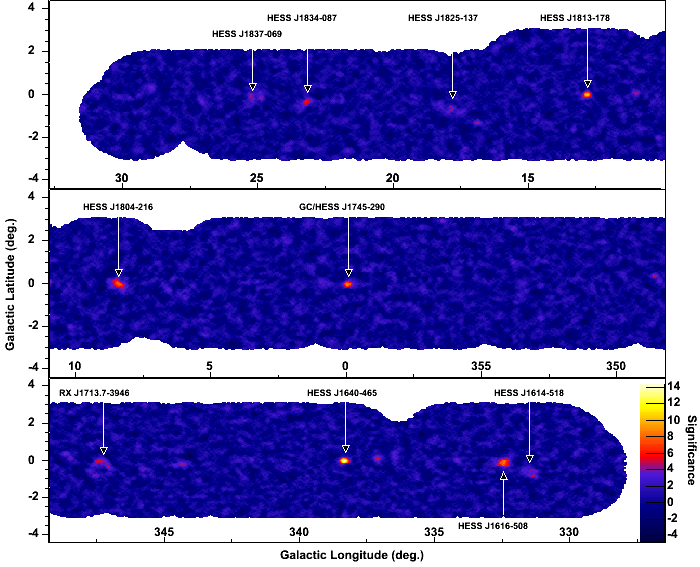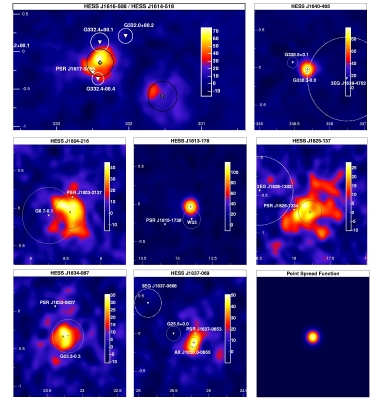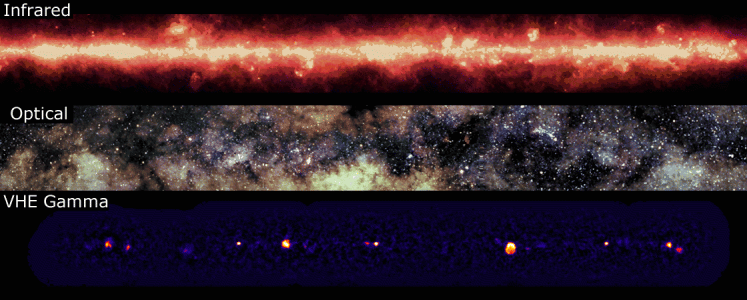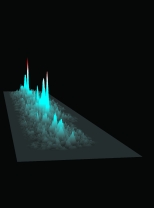Unveiling the
high energy Milky Way
In
a
recent publication in Science Magazine, the H.E.S.S. team of
international astrophysicists reported results of a first sensitive
survey of the central part of our galaxy in very high energy
gamma-rays. This survey reveals
eight
new sources of very high energy gamma-rays in the disk of our Galaxy,
thereby essentially doubling the number of known at these energies.
The results have pushed astronomy into a previously unknown domain, extending
our knowledge of the Milky Way in a novel wavelength regime thereby
opening a new window on our galaxy. Gamma-rays are
produced in extreme cosmic particle
accelerators such as supernova explosions and provide a unique view of
the high energy processes at work in the Milky Way.The results were obtained using the High Energy Stereoscopic System (H.E.S.S.) telescopes in Namibia, in South-West Africa. This system of four 13 m diameter telescopes is currently the most sensitive detector of very high energy gamma-rays, radiation a million million times more energetic than the visible light. These high energy gamma rays are quite rare – even for relatively strong sources, only about one gamma ray per month hits a square meter at the top of the earth's atmosphere. However, since they are absorbed in the atmosphere, a direct detection of a significant number of the rare gamma rays would require a satellite of huge size. The H.E.S.S. telescope employ a trick – they use the atmosphere as detector medium. When gamma rays are absorbed in the air, they emit short flashes of blue light, named Cherenkov light, lasting a few billionths of a second. This light is collected by the H.E.S.S. telescopes with big mirrors and extremely sensitive cameras and can be used to create images of astronomical objects as they appear in gamma-rays.
The H.E.S.S. telescopes represent a multi-year construction effort by an international team of more than 100 scientists and engineers from Germany, France, the UK, Ireland, the Czech Republic, Armenia, South Africa and the host country Namibia. The instrument was inaugurated in September 2004 by the Namibian Prime Minister, Theo-Ben Guirab, and its first data have already resulted in a number of important discoveries, including the first astronomical image of a supernova shock wave at the highest gamma-ray energies.
Particularly stunning is that many of these new sources discovered by H.E.S.S. have no obvious counterparts in more conventional wavelength bands such as optical and X-ray astronomy. The discovery of very high energy gamma-rays from such sources suggest that they may be `dark accelerators', as Stefan Funk from the Max-Planck Institut in Heidelberg affirms: "These objects seems to only emit radiation in the highest energy bands". Indeed, the new sources tend to show `hard' photon spectra, in contrast to most previously known emitters of very-high-energy gamma rays, where spectra decrease more rapidly with increasing energy.
Another important discovery is that the new sources appear with a typical size of the order of a tenth of a degree; the H.E.S.S. instrument for the first time provides sufficient resolution and sensitivity to see such structures. Since the objects cluster within a fraction of a degree from the plane of our Galaxy, they are most likely located at a significant distance – several 1000 light years from the sun – which implies that these cosmic particle accelerators extend over a size of light years.
Notes for Editors
The
H.E.S.S. collaboration
The High Energy Stereoscopic System (H.E.S.S.) team consists
of
scientists from Germany, France, the UK, the Czech Republic,
Ireland, Armenia, South Africa and Namibia.
The H.E.S.S. array
- H.E.S.S. project website
- Chronology of the H.E.S.S. project
- The H.E.S.S. Telescopes
- Project images
- Brochure on H.E.S.S. (Screen Resolution pdf 1.6MB) (Full Resolution ppt 15 MB)
Contacts
Stefan Funk
Max-Planck Institut fuer Kernphysik
Saupfercheckweg 1
69117 Heidelberg
Tel +49 6221 516274
Dr. Jim Hinton
Max-Planck Institut fuer Kernphysik
Saupfercheckweg 1
69117 Heidelberg
Tel +49 6221 516279
Related
Images
 (High Resolution) |
 (High Resolution) Map of the inner 60 degrees of the galactic plane seen in very high energy gamma-rays. The upper right map is divided into three parts for ease of display and is shown again undivided in the bottom panel. The x-axis of this map represents Galactic longitude with the Galactic centre at 0. The y-axis represents Galactic latitude with the disc of the Galactic plane along the latitude 0. The clustering of the new sources along the Galactic plane (i.e. Galactic latitude = 0) is clearly visible. In the upper left panel the same map is shown in a 3-Dimensional representation which shows again the clustering of the new sources along the Galactic plane. |

(Medium
Resolution)
(High
Resolution)
| Close-up view of the
new
sources, discovered in the Galactic plane scan. Shown as white circles
are close-by supernova remnants , that are known to be sources of very
high energy gamma-rays (with the radius of the circle representing the
size of the supernova remnant). Also shown in white are close-by
pulsars, another class of sources of very high energy gamma-rays. |

Sources: Optical image: A.
Mellinger,
Infrared image: S.L. Wheelock, et al. 1994, IRAS Sky Survey Atlas
Explanatory Supplement, JPL Publication 94-11
(High
Resolution)| The galactic
plane as seen in different wavebands in the central part between
Galactic longitude +35 to -35 and Galactic latitude +4 to -4. The top
panel shows the picture of the Milky way in the infrared as recorded by
the IRAS satellite. The Galactic plane is clearly seen as broad strip
running through the middle of the picture. This infrared emission is
mostly due to instellar dust warmed by absorbed starlight. In the
middle panel the optical image of the central part of our Galaxy is
shown as it can be seen by the naked eye in clear nights. Most of the
central part of the Galaxy is hidden by the above mentioned
interstellar dust. Most of this starlight is emitted by stars that are
close to the solar system on the scale of the Milky way. The bottom
panel shows the new picture of the Milky way as seen by H.E.S.S. in
very high energy gamma-rays. Individual sources of this radiation can
be clearly seen. The big bright source is the supernova remnant RX
J1713.7-3946 that has recently been reported by the H.E.S.S.
collaboration. It can be clearly seen, that most of the new sources of
very high energy gamma-rays cluster along the Galactic plane. |
